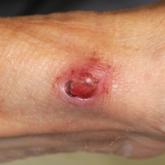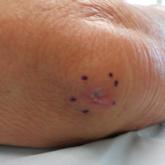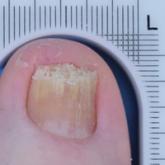Original Research

Mycobacterium marinum Remains an Unrecognized Cause of Indolent Skin Infections
We identified 5 patients who had cutaneous lesions with cultures that yielded Mycobacterium marinum. It was discovered that all 5...
Dr. Landero was from Wellington Regional Medical Center, Florida, and currently is from Premier Dermatology, Abilene, Texas.
The author reports no conflict of interest.
Correspondence: James Landero, DO, 1525 Hickory St, Abilene, TX 79601 (landero7@yahoo.com).

The case of a 58-year-old man with a pruritic rash involving the pubic area that had been undiagnosed for 30 years is presented. At least 15 different primary care physicians and dermatologists evaluated the patient during this time period. Multiple treatments were unsuccessful and a definitive diagnosis was not rendered. Wood lamp evaluation of the pubic area revealed hair shaft concretions that were confirmed on histologic evaluation to be white piedra (WP). The patient was successfully treated with topical ketoconazole and the eruption completely resolved. Our case raises awareness of the use of Wood lamp and dermoscopy to evaluate for parasitic infections of the pubic hair shafts when nonspecific dermatitis presents in this area.
Practice Points
A 58-year-old man presented for evaluation of a pruritic rash involving the pubic area of 30 years’ duration. Multiple primary care physicians and dermatologists had evaluated the patient during this period, but he noted a specific diagnosis had not been rendered and multiple treatments had been unsuccessful. The patient described a rash, which was absent at the time of evaluation, as a self-remitting and exacerbating irritation typically induced by sweating and physical activity. The patient also stated that the irritation was associated with a strong, distinct, musty odor that severely interrupted his sex life and decreased his quality of life. Prior treatments included various topical corticosteroids, topical and oral antibiotics, and various homeopathic treatments that were minimally efficacious or nonefficacious. He was unsure if antifungals had previously been prescribed.
The patient’s medical history was notable for pulmonary interstitial fibrosis, anxiety, posttraumatic stress disorder, and mild glucose intolerance. The patient had no pertinent surgical history and no known drug allergies. Current medications included a bronchodilating inhaler, escitalopram, trazodone, buspirone, clonazepam, prazosin, gabapentin, and azithromycin for current upper respiratory tract infection. The patient was a former smoker and a social drinker.
On physical evaluation the pubic area displayed slight patchy erythema without a papular component and was otherwise unremarkable to the unaided eye. Upon palpation of the skin, there were no remarkable findings. Under dermoscopic evaluation, small white-yellow concretions along the hair shaft were noticed. Evaluation with a Wood lamp is shown in Figure 1.
The patient was treated empirically with ketoconazole cream 2% applied to the affected area once daily until follow-up 3 weeks later. The patient also was advised to shave the pubic area to remove potentially infected hairs, as white piedra (WP) was suspected. A diagnosis of WP was confirmed on histologic evaluation of pubic hair samples approximately 1 to 2 weeks later (Figure 2).
At 3-week follow-up, Wood lamp evaluation did not identify concretions along the pubic hair shafts. The patient was symptom free and extremely pleased. Of note, the patient did not shave the pubic area and was counseled on recurrence.

We identified 5 patients who had cutaneous lesions with cultures that yielded Mycobacterium marinum. It was discovered that all 5...

To the Editor: A 69-year-old woman with no history of immunodeficiency presented 1 month after a thorn from her locally grown Madagascar palm...

There currently are 3 topical agents approved by the US Food and Drug Administration (FDA) to treat onychomycosis: tavaborole, efinaconazole, and...
